How Did Queen Elizabeth Change English Culture
 Queen Elizabeth 1 (1533 – 1603) of England was the ultimate feminist and an 'Iron Queen'. She fashioned herself and her kingdom into a major globe power past believing in the qualities of the men who surrounded her, exploiting their weaknesses and admiring their strengths. While motivating and inspiring them she too sought to circumscribe their power in clever means.
Queen Elizabeth 1 (1533 – 1603) of England was the ultimate feminist and an 'Iron Queen'. She fashioned herself and her kingdom into a major globe power past believing in the qualities of the men who surrounded her, exploiting their weaknesses and admiring their strengths. While motivating and inspiring them she too sought to circumscribe their power in clever means.
O, for a Muse of fire, that would ascend
The brightest heaven of invention;
A kingdom for a stage, princes to act
And Monarchs to behold the swelling scene! *
The so-called Rainbow portrait of Queen Elizabeth 1 is attributed to Isaac Oliver and a neat treasure in England, besides every bit a vision of her power and influence. Portraiture was a tool of propaganda and Elizabeth was a truthful principal of the game. She presented herself as a magnificent keepsake of virtuous statehood.
Her costume, preference for particular colours, advisedly crafted jewellery and elaborate headdresses, as well every bit other decorative accessories are revealed in swell item. It was painted around 1600 – 1602 when the Queen was in her sixties.
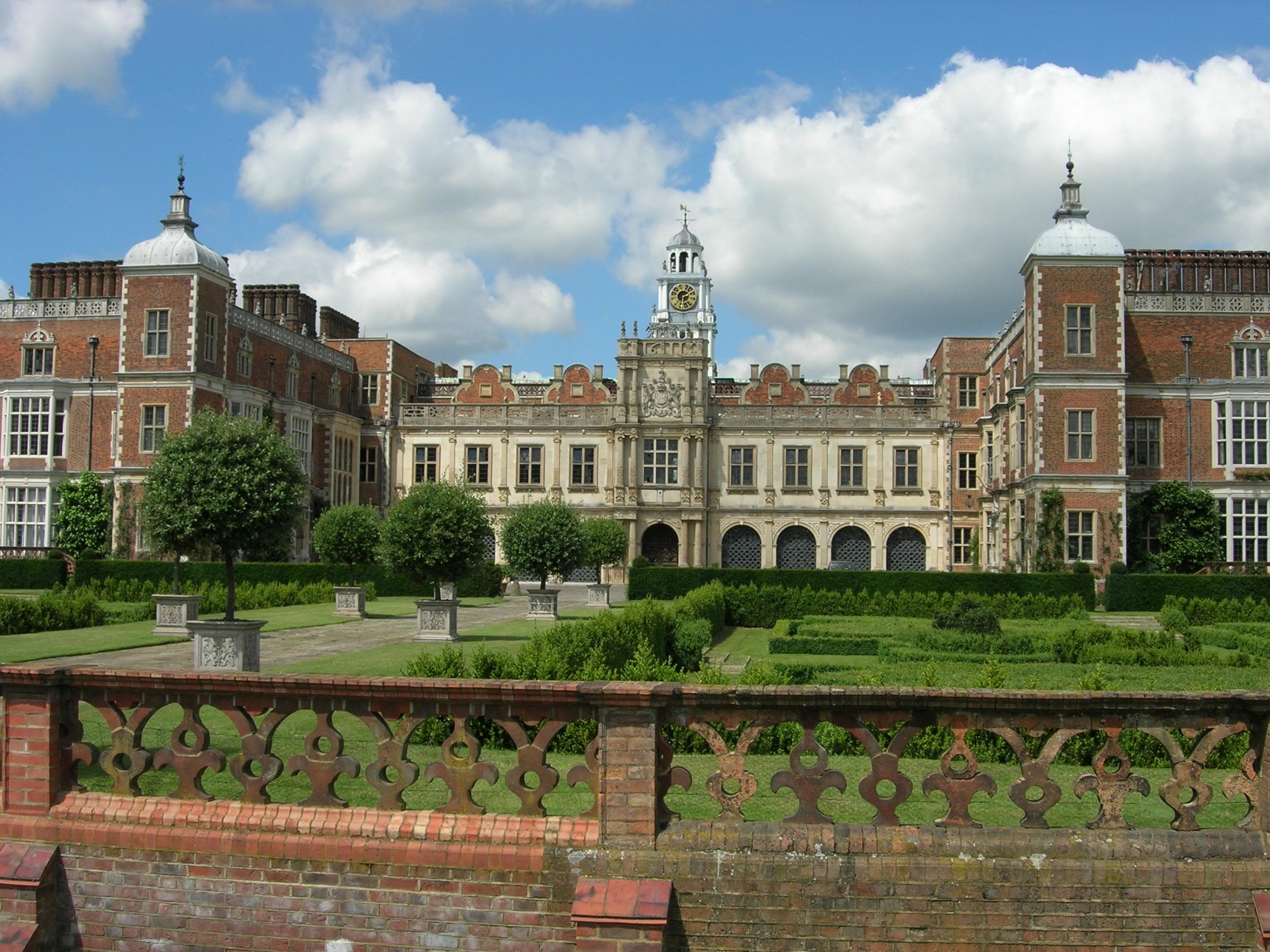 Information technology was known to be at Hatfield House in 1719, the country residence of the Cecil family and prior to that is believed to have been in Salisbury House, their London establishment.
Information technology was known to be at Hatfield House in 1719, the country residence of the Cecil family and prior to that is believed to have been in Salisbury House, their London establishment.
The most spectacular of her bodkins in the Rainbow portrait was the crescent pinned to her headdress. She personifies the sun that brings the rainbow as a symbol of peace following a tempest.
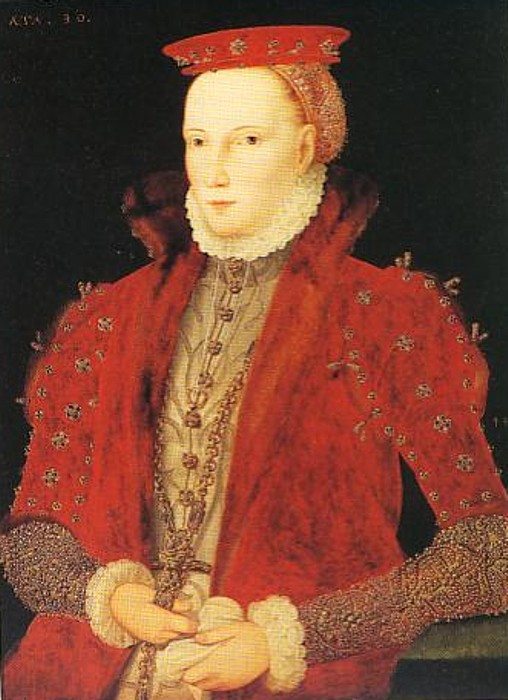 The crescent is significant in that it is fix with a ruby and diamonds and tipped with pearls. The value of the jewels were besides attached to their beauty; rubies were ripe like a pomegranate, a symbol of prosperity, diamonds were for endurance while pearls meant purity.
The crescent is significant in that it is fix with a ruby and diamonds and tipped with pearls. The value of the jewels were besides attached to their beauty; rubies were ripe like a pomegranate, a symbol of prosperity, diamonds were for endurance while pearls meant purity.
Over the long length of her reign (1558 – 1603) William Cecil and his son Robert were her most trusted advisers and 1st Ministers. Many portraits of Elizabeth i were produced during her lifetime, although few were made direct from life. None were so heavily symbolic every bit this one.
Those portraits of her that are not overtly emblematic were total of significant to a discerning eye of the time. Elizabethan courtiers were very familiar with the language associated with flowers and would have been able to read stories in the flowers on her gown, the images depicted on the embroidery on her apparel, and the design of her jewels and headdresses.
 She was given a neat bargain of jewellery as a 'love souvenir', however none more acceptable to her than that from her favourite the Earl of Leicester.
She was given a neat bargain of jewellery as a 'love souvenir', however none more acceptable to her than that from her favourite the Earl of Leicester.
In the so-called Fleet portrait she wears the incredible strings of natural pearls that he gave to her in dearest and friendship.

Sir Walter Raleigh, Sir John Hawkins and Sir Francis Drake Queen Elizabeth 1's privateers, or pirates, dependent on your point of view
She is wearing Chandelier earrings with a cross bar of three diamonds supporting a large lozenge shaped diamond betwixt two hanging pearls, 3 ruby drops and finally a pear pearl.
As a record of facial likeness the many portraits of the Queen were rarely accurate. They were however significant show of the majesty of monarchy.
… but till all graces be in one woman, one woman shall non come in my grace. Rich she shall be, that's sure; wise or I'll none; virtuous, or I'll never cheapen her; fair or I'll never look on her; mild, or come non near me; noble, or non I for an angel; of expert discourse, an excellent musician, and her hair shall be of what colour it please God *

'in blacke witha hoode and cornet' – the Clopton Portrait of Elizabeth painted 1558 – 60
From the moment of her birth the Titian haired Elizabeth one changed the course of history past being a girl, not the longed for son King Henry Eight (1491 – 1547) her lion-similar begetter and her beauteous female parent Anne Boleyn (b1500-1509 – 1536) the 'almost happy' but ill-fated second Queen of England, had wanted.
Her mother was beheaded on Tower Green before Elizabeth was three years former and her death ready in move a blueprint of events that would accept long lasting furnishings for her only living child.
Like most children of her fourth dimension and station Elizabeth was sent away from courtroom to be educated, in her case at first when she was iii months old.
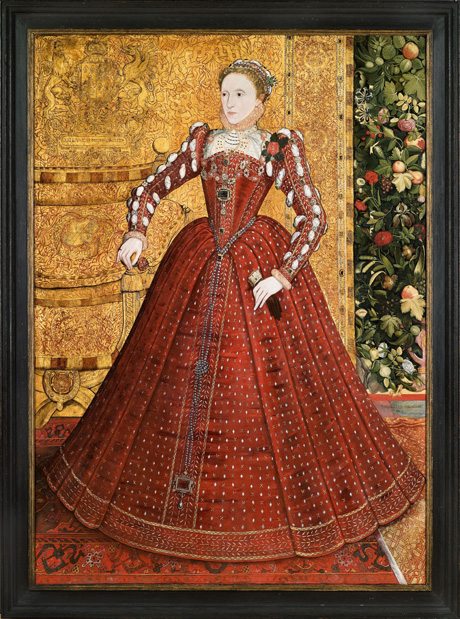
Hampden Portrait Elizabeth 1, courtesy V & A Museum, London
This is when she went on her first progress to the household of her great uncle at Hatfield House, a palace in Hertfordshire. Her first governess Lady Margaret (Muggie) Bryan would take her to come across her parents on special occasions and festivals such as Christmas. She did everything to assist her charge through the dreadful downfall of her mother, but was replaced past a new governess when Elizabeth was only four years old. Kat Ashley came from Devon. She was a well educated, loving and affectionate governess. She became completely devoted to Elizabeth, who came to love Kat dearly.
She played an of import role in her life as both a friend and confidante. She praised Kat's early devotion to her studies by stating that she took "corking labor and pain in bringing of me up in learning and honesty".
Elizabeth'southward beloved of learning enabled her to embrace new subjects with great ease and enthusiasm. Her studies included languages, grammar, theology, history, rhetoric, logic, philosophy, arithmetic, logic, literature, geometry, and music. Her religious studies were guided by Matthew Parker, who had been charged with her spiritual well being.
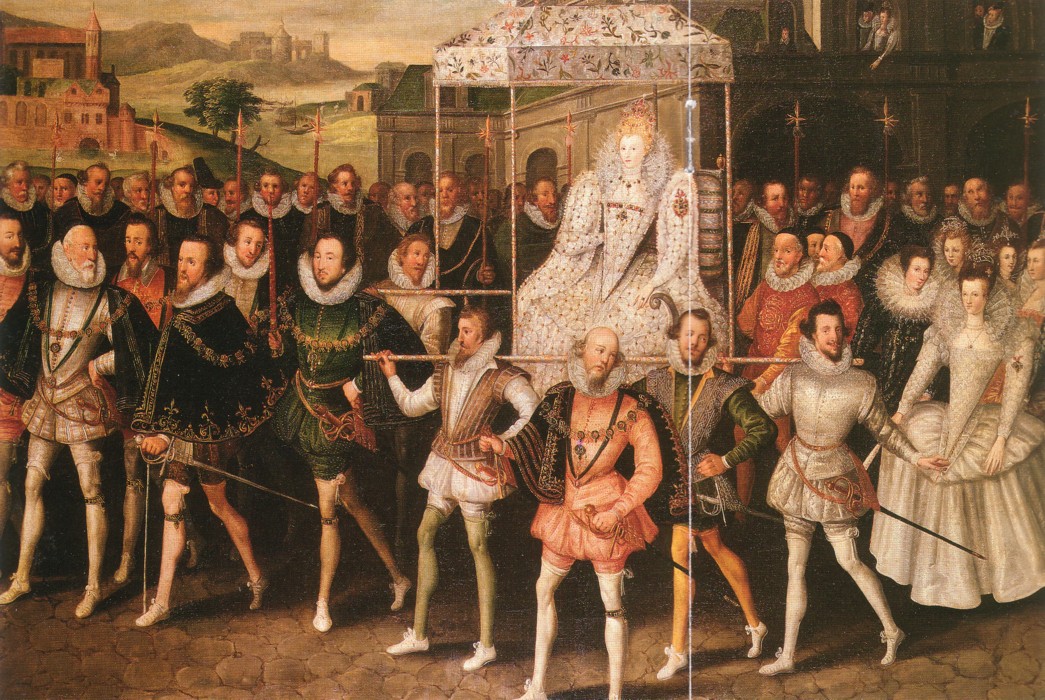 Bully attention was given to her study of languages. One of her tutor's Roger Ascham'southward nigh widely known and accustomed educational device was double translation.
Bully attention was given to her study of languages. One of her tutor's Roger Ascham'southward nigh widely known and accustomed educational device was double translation.
He praised her aptitude in learning languages and her amazing retentive retentiveness. Ascham wrote that Elizabeth developed a style that "grows out of the subject; chaste considering it is suitable, and beautiful considering it is clear'. He likewise said 'Her ears are so well practiced in discriminating all these things and her judgment is and then good, that in all Greek, Latin, and English language compositions in that location is nothing so loose on the i hand or so concise on the other which she does non immediately attend to, and either pass up with disgust or receive with pleasure as the example may be."

Elizabeth 1 of England by Marcus Gheeraerts the Elderberry
Her daily lessons were divided into morning and afternoon. By the age of eleven Elizabeth was able to speak six languages fluently; French, Greek, Latin, Spanish, Welsh and English language.
She acquired a taste for fine books and grew upwards with a dislike of the coquetries enacted by some of the women of her historic period.
Elizabeth 1 had intelligence, a strong will and strength of purpose, all of which were necessary attributes for survival in the world of political intrigues surrounding the court of her father. She acquired a disdain for depression political intrigues and later on in life ever tried to have the high ground.
Elizabeth 1 lived through eye racking years of incertitude, many in prison or close solitude, with stepmothers coming and going. She was surrounded by masters of manipulation and learned the feminine skills of sewing, embroidery, dancing and music and the more than manly arts of archery, riding and hunting.
The greatest compliment made to her by her last tutor Roger Ascham was that she had the intelligence of a man and noted that this would hold her in fantabulous stead in the years of her reign.

The Darnley Portrait of Elizabeth 1 of England
She came to the throne at the age of 25, offer the English people a chance for a fantabulous future. When she received the news she was Queen of England it is recorded that as the courtiers who came bearing the news bowed earlier their new queen, Elizabeth got on her knees and said in Latin, "This is the Lord's doing, and it is marvelous in our eyes."
During her reign a higher value would be placed on political freedom, public spiritedness and complimentary research She embraced some Renaissance ideals; life was no longer viewed through a vale of tears, merely equally a quest for enlarging human being'southward powers and his sensation of God.
Her well-nigh famous explorers, or privateers were really pirates attacking the Spanish treasure fleet and Spanish colonies to bring the haul home to her.
Following Elizabeth's accretion a building boom had begun and she fuelled the contest between her nobles. A groovy traveler she liked to cheque upwardly on her subjects at their cost and historians have suggested she did on purpose to get overambitious subjects into financial difficulties so that she could keep them in control.
The population totally adored her as each summer she set off to visit palaces built to divert and seduce her.
 Her Royal progresses combined pomp, poetry, chaos and celebration with at their centre a permanent virgin ruler, with an informed, scholarly mind, who delighted in silk stockings, jewels, flattery, music and higher up all, dancing. Her charismatic reign would produce some of the virtually creative minds in English history.
Her Royal progresses combined pomp, poetry, chaos and celebration with at their centre a permanent virgin ruler, with an informed, scholarly mind, who delighted in silk stockings, jewels, flattery, music and higher up all, dancing. Her charismatic reign would produce some of the virtually creative minds in English history.
She absorbed at 'heart stage' amid the glittering courtiers, fashionable foreign dignitaries, handsome sea captains, passionate playwrights and above all her people, whom she devoted all her energies to serving. They all jostled for her favour in an age that admired the grotesque among the beautiful.
Elizabeth always trusted her Spiritual advisor, although her sister Mary hated him due to his Protestant beliefs. When Elizabeth became Queen in the Nov of 1558, information technology was widely believed she would restore the Protestant faith in England.
During her sister Queen Mary's 5 twelvemonth dominion her persecution of Protestants had done much damage to the standing of Catholicism in England. Elizabeth adhered to the Catholic religion during her sis's reign as a affair of survival. Mathew Parker had ensured that she had been raised a Protestant, and she was committed to that faith.
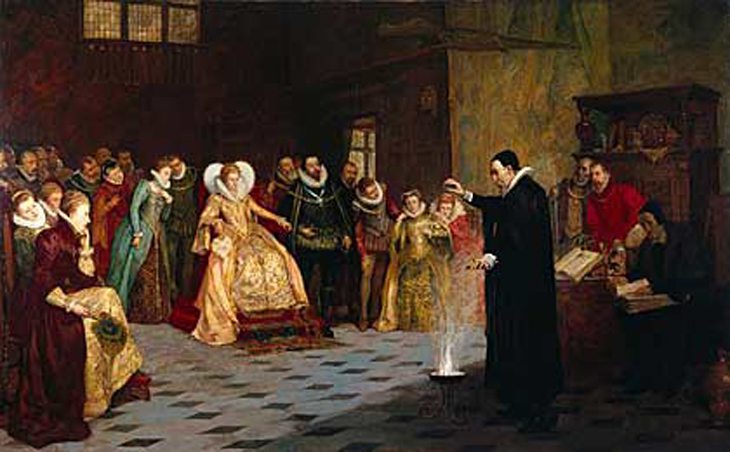
John Dee performing an experiment before Queen Elizabeth I.Credit: Wellcome Library, London.
She saw herself as God's vessel on earth, and would pray to make up one's mind God's will so that he would reveal information technology to her, and she could implement it. She also declared that she had "no desire to make windows into men'due south souls". When Elizabeth became Queen she had appointed Matthew Parker Archbishop of Canterbury.
In her age Elizabeth's religious views were remarkably tolerant. She believed sincerely in religious toleration, and that Catholics and Protestants were both role of the aforementioned religion. "There is only i Christ, Jesus, ane faith" she exclaimed later on in her reign, "all else is a dispute over (human being made) trifles."

Elizabeth and her courtiers, Hatfield House
Unfortunately for Elizabeth many of her contemporaries did not share her views on toleration.
Circumstances often demanded that she had to adopt a far harsher line towards Catholics than she intended or wanted. Her refusal to make changes to the Church she established in 1559, has led some historians to doubt her delivery to her faith but we know she prayed daily in her ain individual chapel.
The form of worship suited the Queen'south conservative stance. She had niggling sympathy with extremists of whatever kind, especially those who wanted to strip the Church of it'south finery, to ban choral music, the wearing of beautiful vestments and bell ringing.
She liked her Church simply the style information technology was.
 Elizabeth hoped that people would gradually become accustomed to it. Her whole stance as elevating herself to the admiration of a Virgin Queen is suggested by some historians every bit making herself a replacement for the Virgin Female parent of Christ, Mary who many would accept missed worshiping when she changed the faith to Protestanism.
Elizabeth hoped that people would gradually become accustomed to it. Her whole stance as elevating herself to the admiration of a Virgin Queen is suggested by some historians every bit making herself a replacement for the Virgin Female parent of Christ, Mary who many would accept missed worshiping when she changed the faith to Protestanism.
Elizabeth 1 wanted her Church to be pop with her people, and for Catholicism to dice out naturally as people turned to the religion she had established.
In this she was largely successful, for by 1603, the English nation as a population were generally Protestant, and Catholics were in the minority.
She would not have e'er foreseen the arrival of the Puritans, Oliver Cromwell, England's Civil War and the powers of the monarchy being circumscribed as a direct issue. With the enormous upheaval that followed the pause with Rome the connection between faith and art became nigh lost.
While the great English tradition of embroidery continued it was entirely secular utilize, not re-emerging every bit an aspect of the original opus anglicanum until a motion for the revival of Catholic doctrine and observance in the Church of England began at Oxford Academy in 1833.
 George 2 (1683 – 1760) described a demote of his bishops as a 'parcel of black, canting, hypocritical rascals'; and at that place was a great deal of corruption due to a great divide betwixt rich bishops and poor curates.
George 2 (1683 – 1760) described a demote of his bishops as a 'parcel of black, canting, hypocritical rascals'; and at that place was a great deal of corruption due to a great divide betwixt rich bishops and poor curates.
The Oxford Movement aimed at the restoration of 'High Church principles' and several causes contributed to its being seen as desirable. They included the decline of Church life, the spread of 'liberalism in theology' and the question of Anglican identity, which had suffered enormously during the eighteenth century with the lack of respect for clergymen generally.
During the nineteenth century Augustus Welby Northmore Pugin led the charge for a Gothic revival when Victoria came to the throne.
 At Cambridge with a revival of liturgical knowledge a widely diffused gustation for ecclesiastical design in the fabric and furniture of the church sprang up, promoted by the works of Pugin.
At Cambridge with a revival of liturgical knowledge a widely diffused gustation for ecclesiastical design in the fabric and furniture of the church sprang up, promoted by the works of Pugin.
He provided much of the foundation for the emergence of modern Art
The Roman Catholics benefited from all of this activity following Cosmic Emancipation in 1829 and religious tolerance, as formerly desired by Elizabeth ane was re-instated. Just then there was more.
Information technology has directly led to the emergence in the 21st century of respect for all religions and cultures in our world today.
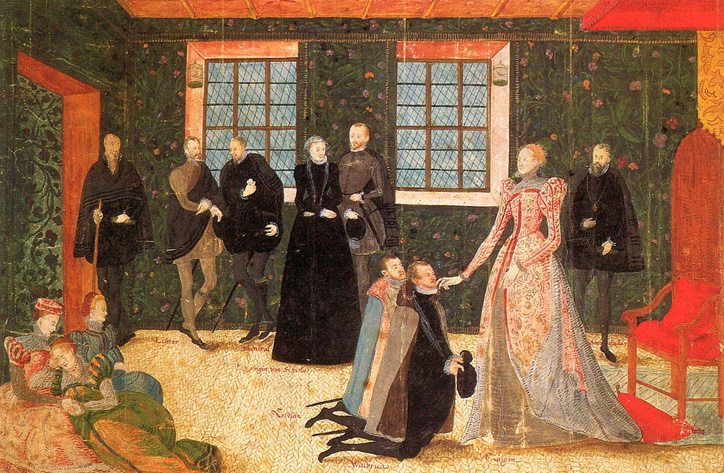
Queen Elizabeth 1 greeting Dutch Ambassadors courtesy Kasell National Museum, Federal republic of germany
We would take to conclude that Queen Elizabeth 1 really had no peer, at least in terms of her wit, style, endurance and courage. She was a larger than life character on the world phase of her fourth dimension.
Carolyn McDowall, The Civilization Concept Circle, 2012-2019
* Quotes by Queen Bess's favourite playwright William Shakespeare
1. Henry V: Prologue- Chorus, "O for a Muse of Fire…" 2. Much Ado Most Nothing: Act II: ii – Benedict, "I practice much wonder that i man…"
In that location has been controversy particularly in modern times over whether he, William Shakespeare, actually wrote the plays that bear his name. Some accept suggested it was the earl of Oxford, others Sir Francis Bacon, fifty-fifty to the near fanciful that information technology was all Good Queen Bess (Elizabeth I)'due south ain piece of work.
The well-nigh authoritative word on that controversy comes from Sir Laurence Olivier, the 20th century's greatest Shakespearean interpreter who laid to residual the question of the authorship of the plays when he said, "No self respecting player would ever have worked for the Regal Salary Company."
Source: https://www.thecultureconcept.com/elizabeth-1-the-iron-queen-portrait-of-power-and-influence
Posted by: benoitcabol2001.blogspot.com


0 Response to "How Did Queen Elizabeth Change English Culture"
Post a Comment